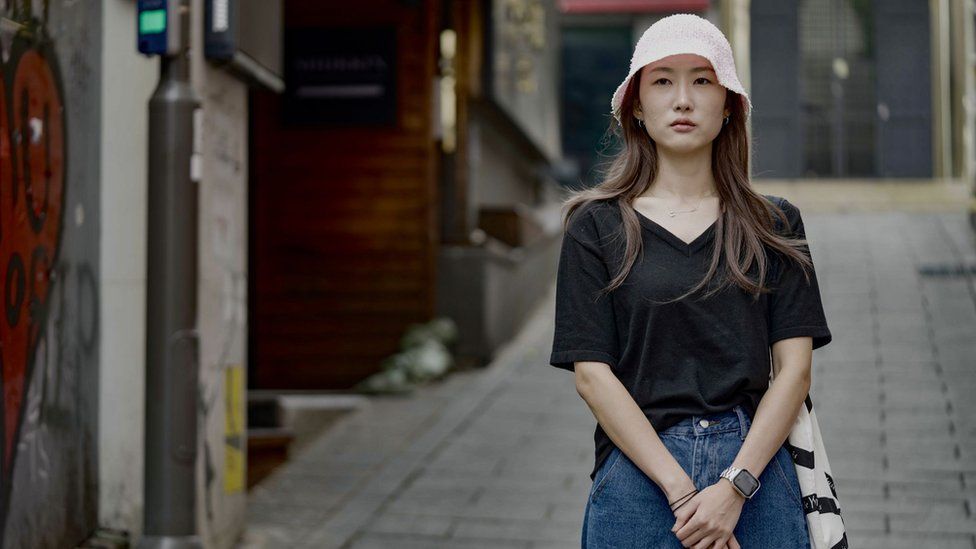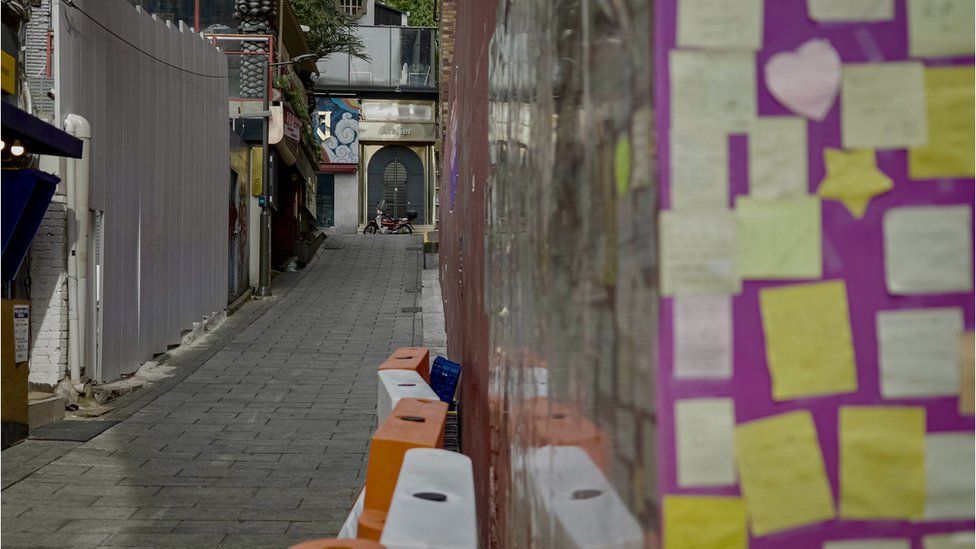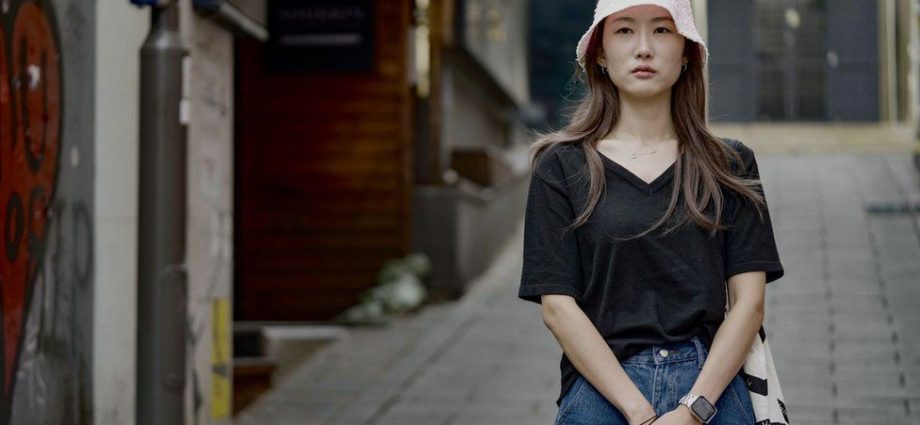
One year on from the horrific crowd crush that killed nearly 160 young people, Lee Ju-hyun returned to the alleyway where she almost died.
She visits regularly, determined to keep her memories of that awful night alive until justice has been served.
It was Halloween weekend, and more than 100,000 people had descended on Seoul’s labyrinth-like neighbourhood of Itaewon – a popular nightlife district – to party.
They funnelled into a narrow, steep passage from three directions, until it became so tightly packed people could not move. Some could not breathe. Many died.
Despite multiple, well-documented failings by the authorities, a year on, no one has been held responsible, leaving the survivors and the bereaved struggling to heal.
Ju-hyun can locate the exact spot where she tripped and fell to the floor as people then piled on top of her. The pressure was so great, the muscles in her legs ruptured, paralysing them, and she lost consciousness. She awoke, still trapped, to the sound of chaos.
“There were screams everywhere. Those in the crowd were screaming ‘please help me, I don’t want to die’, while those in a club who could see what was unfolding were shouting ‘please don’t die; please don’t die.'”
Gradually the screams and prayers receded.
Now much of the ghostlike alleyway is boarded up. Some of its bars never reopened. And thousands have been left haunted, either by the horror of enduring the crush, or by the loss of loved ones who did not make it.

Park Jin-sung lives with both.
He was visiting Seoul with his mother and younger sister. Intrigued by the Halloween parties in Itaewon, they decided to check them out. By the time they arrived, the alleyway was heaving and Jin-sung urged his sister to escape, while he stayed behind to look after their mother.
He held her as she struggled to breathe, creating a tiny pocket of space between them, so she could draw air into her lungs. When the paramedics arrived, he pulled her out through a gap in the crowd.
He ran around the streets and hospitals, his muscles fatigued, searching for his sister, until the police called him from the morgue. “That was when the world collapsed on me”, he said. “Initially, I wasn’t able to leave the house. I was very scared at night. A tiny sound would paralyse me.”
Both he and his mother quit their jobs.
A year on, Jin-sung is working again, and his fear and sadness have been replaced by anger.
Many of the survivors, along with the families of the bereaved, say they have still not been given adequate answers as to what went wrong that night.
An initial investigation concluded that local government officials had failed to adequately plan for the event by putting crowd control measures in place. It also found police had ignored calls from concerned attendees warning about the crowds before the crush turned deadly. The emergency services then failed to get paramedics to the site in time.
But there has been little explanation as to why such mistakes were made, especially since the authorities had anticipated large crowds – and had foreseen and documented the potential for danger.

Twenty-three police officers and government officials have been charged with criminal offences including involuntary manslaughter and negligence. Many remain in their jobs, even while their trials and investigations are ongoing.
More senior politicians and officials, including the interior minister, the mayor of Seoul and the National Police Agency have been cleared of wrongdoing.
For Park Jin-sung, this is proof the disaster has not been properly investigated. He and other families are pushing for a new, independent investigation, which is currently awaiting parliamentary approval. “They’ve not held even one meeting to explain what happened and say, ‘look, we’re really, really sorry'”. Even that would have been enough to ease his pain, he said.
In the aftermath of the disaster, the government set up a trauma centre to provide counselling to survivors. Jin-sung receives a text once a week offering support, but he has not responded. “It’s run by the government, and I don’t trust the government very much, so I don’t feel comfortable going there”, he said.
For one survivor, 16-year-old Lee Jae-hyun, the trauma proved too much to bear. He was wedged in the centre of the crowd with his best friend and girlfriend, helplessly watching her lose consciousness, before he too stopped breathing. From his hospital bed, he learnt that both she and his friend had died, making them two of the youngest victims.
Forty-three days after the disaster Jae-hyun took his own life, making him victim number 159.
“He was a completely different boy after the tragedy”, his mother, Song Hae-jin, told us. “Before, he was a cheerful, talkative kid. Afterwards, he almost never spoke. He sat alone in his room, unable to sleep”.
There is no official memorial to the victims of the crush. Their families take it in turns to watch over the altar, adorned with photos of the dead, lest the authorities try to remove it; something they have threatened to do.

Hae-jin described the relationship between the families and the authorities as problematic. After the crush, she claims they were ostracised, as various authorities tried to avoid taking responsibility. In the immediate aftermath, some people even pointed fingers at the survivors and the dead, suggesting they were to blame for going out that night. Hae-jin recalled how much this upset her son.
“Ultimately it was the government and local authority that failed to serve their duty to protect lives. There has been no accountability for that at all. In order to heal, we need to clarify why this happened and who was responsible”, she said, adding that she would feel guilty until the day she died for not protecting her son.
Psychiatrist Paik Jong-woo, from Kyung Hee University Medical Centre, argues that the politicisation of the disaster and the lack of accountability have made it harder for survivors and the bereaved to recover. He created a psychological support group to counsel them, after realising very few were receiving help.
“As a society we need to take care of the victims and show them how we plan to prevent this from happening again. Then they can find comfort in the belief that lives were not lost in vain, but have made our society safer”, he said.
The government, the Seoul city council and the police turned down our requests for an interview about what lessons they had learnt and how they planned to keep people safe this Halloween. They told us this was not the right time to talk.
In a statement, the government said it was “deeply saddened by the tragedy and has been expressing its apologies and sympathies to the victims and their families at every opportunity”.
The authorities did detail some new safety measures they had introduced. Now, when three calls are made to the police within a 50 metre radius, they are automatically flagged – and emergency services are forced to work together when requested; no longer can they refuse call outs, as happened in the early minutes of the crush. Meanwhile, a new CCTV system is being rolled out across Seoul to monitor crowd densities.
However the district authority, Yongsan, which was criticised for not implementing safety measures ahead of the event, refused to answer any of our questions about what changes, if any, it had made.
Itaewon’s upcoming Halloween celebrations are expected to be a far quieter affair. Some bars and clubs have announced they will not be hosting parties. Lee Ju-hyun, however, plans to attend. “I want to show people it’s not our fault we came here to enjoy ourselves”, she said.
After spending two months in hospital, her legs have now mostly recovered, barring some pain on her right side when she stands for too long, and her initial trauma has subsided.
Though as she stopped to read the colourful notes of condolence, stuck along one wall of the alleyway, a single tear trickled down her cheek.
“I’m sad for those who died and those they left behind”, she said. “I always stop here to ask them ‘what do you need us survivors to do for you?'”
Additional reporting by Hosu Lee and Leehyun Choi.

